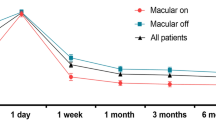Abstract
Purpose
To establish the frequency and the risk factors for iatrogenic retinal breaks during three-port pars plana vitrectomy (PPV).
Methods
A total of 2471 PPV operations were included in the study. The study period was between 2001 and 2010, all the data were entered in an electronic patient record database. All 270 consecutive eyes of 270 patients developing iatrogenic retinal breaks during primary PPV were matched to 270 controls. Univariate and multivariate analysis were performed to establish the risk factors.
Results
The median age of the patients with iatrogenic breaks was 60.06 years; male to female ratio was 140/130. The overall frequency of iatrogenic retinal breaks was 10.09%. The frequency of iatrogenic retinal breaks for eyes undergoing PPV for tractional retinal detachment (TRD) was 32.45%. The lens status was phakic in 79.6% of the eyes, with iatrogenic breaks compared with 34.4% of the eyes in control group (P<0.001). Posterior vitreous was attached in 58.9% of the eyes with iatrogenic breaks compared with 50.4% of the eyes in control group (P=0.04). Internal limiting, epiretinal, proliferative, or fibrovascular membrane removing manoeuvers were performed in 71.1% of the eyes with iatrogenic breaks compared with 61.9% of the eyes in control group (P=0.052).
Conclusion
Eyes undergoing PPV for TRD had significantly higher frequency of iatrogenic retinal breaks compared with other subgroups (P=0.0001). Phakia and absence of PVD were found to be risk factors for iatrogenic retinal breaks.
Similar content being viewed by others

Log in or create a free account to read this content
Gain free access to this article, as well as selected content from this journal and more on nature.com
or
References
Moore JK, Scott IU, Flynn Jr HW, Smiddy WE, Murray TG, Kim JE et al. Retinal detachment in eyes undergoing pars plana vitrectomy for removal of retained lens fragments. Ophthalmology 2003; 110: 709–713.
Heier JS, Topping TM, Frederick Jr AR, Morley MG, Millay R, Pesavento RD . Visual and surgical outcomes of retinal detachment following macular hole repair. Retina 1999; 19: 110–115.
de Bustros S, Thompson JT, Michels RG, Rice TA, Glaser BM . Vitrectomy for idiopathic epiretinal membranes causing macular pucker. Br J Ophthalmol 1988; 72: 692–695.
Oyakawa RT, Schachat AP, Michels RG, Rice TA . Complications of vitreous surgery for diabetic retinopathy. I. Intraoperative complications. Ophthalmology 1983; 90: 517–521.
Carter JB, Michels RG, Glaser BM, De Bustros S . Iatrogenic retinal breaks complicating pars plana vitrectomy. Ophthalmology 1990; 97: 848–853.
Chung SE, Kim KH, Kang SW . Retinal breaks associated with the induction of posterior vitreous detachment. Am J Ophthalmol 2009; 147: 1012–1016.
Krohn J . Duration of face-down positioning after macular hole surgery: a comparison between 1 week and 3 days. Acta Ophthalmol Scand 2005; 83: 289–292.
Moore JK, Kitchens JW, Smiddy WE, Mavrofrides EC, Gregorio G . Retinal breaks observed during pars plana vitrectomy. Am J Ophthalmol 2007; 144: 32–36.
Sjaarda RN, Glaser BM, Thompson JT, Murphy RP, Hanham A . Distribution of iatrogenic retinal breaks in macular hole surgery. Ophthalmology 1995; 102: 1387–1392.
Tan HS, Mura M, de Smet MD . Iatrogenic retinal breaks in 25-gauge macular surgery. Am J Ophthalmol 2009; 148: 427–430.
Theocharis IP, Alexandridou A, Gili NJ, Tomic Z . Combined phacoemulsification and pars plana vitrectomy for macular hole treatment. Acta Ophthalmol Scand 2005; 83: 172–175.
Wimpissinger B, Binder S . Entry-site-related retinal detachment after pars plana vitrectomy. Acta Ophthalmol Scand 2007; 85: 782–785.
Guillaubey A, Malvitte L, Lafontaine PO, Hubert I, Bron A, Berrod JP et al. Incidence of retinal detachment after macular surgery: a retrospective study of 634 cases. Br J Ophthalmol 2007; 91: 1327–1330.
Michels RG . Vitrectomy for macular pucker. Ophthalmology 1984; 91: 1384–1388.
Banker AS, Freeman WR, Kim JW, Munguia D, Azen SP . Vitrectomy for Macular Hole Study Group. Vision-threatening complications of surgery for full-thickness macular holes. Ophthalmology 1997; 104: 1442–1452.
Park SS, Marcus DM, Duker JS, Pesavento RD, Topping TM, Frederick Jr AR et al. Posterior segment complications after vitrectomy for macular hole. Ophthalmology 1995; 102: 775–781.
Tabandeh H, Chaudhry NA, Smiddy WE . Retinal detachment associated with macular hole surgery: characteristics, mechanism, and outcomes. Retina 1999; 19: 281–286.
Williamson T . Vitreoretinal Surgery. Springer: Berlin, 2008. ISBN:3540375813.
Al-Harthi E, Abboud EB, Al-Dhibi H, Dhindsa H . Incidence of sclerotomy-related retinal breaks. Retina 2005; 25: 281–284.
Ramkissoon Y, Shaheen S, Shah P, Wong S, Sullivan P . Risk of iatrogenic peripheral retinal breaks in 20-G pars plana vitrectomy. Ophthalmology 2010; 117: 1825–1830.
Author information
Authors and Affiliations
Corresponding author
Ethics declarations
Competing interests
The authors declare no conflict of interest.
Rights and permissions
About this article
Cite this article
Dogramaci, M., Lee, E. & Williamson, T. The incidence and the risk factors for iatrogenic retinal breaks during pars plana vitrectomy. Eye 26, 718–722 (2012). https://doi.org/10.1038/eye.2012.18
Received:
Accepted:
Published:
Issue date:
DOI: https://doi.org/10.1038/eye.2012.18
Keywords
This article is cited by
-
Characteristics and outcomes of full-thickness macular holes created during vitrectomy for proliferative diabetic retinopathy
International Ophthalmology (2023)
-
Comparative study of combined vitrectomy with phacoemulsification versus vitrectomy alone for primary full-thickness macular hole repair
BMC Ophthalmology (2021)
-
United Kingdom National Ophthalmology Database Study of Vitreoretinal Surgery: Report 1; Case mix, complications, and cataract
Eye (2013)

